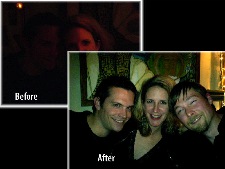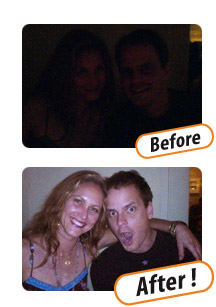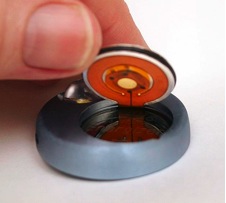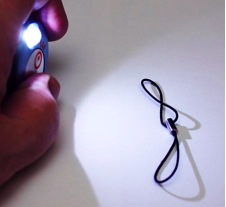To use Phlash, you have to hold the button down, not just momentarily press it. In other words, the Phlash's intense blue-ish light has to shine on the subject before the Treo's camera "shutter" fires, and it has to stay on while the picture "snaps" -- three or so seconds, total. You can let go of the button when the snapshot appears on the Treo screen. To maximize battery life, minimize the amount of on time.
The accompanying before/after pictures show you know what kind of results to expect. The source for all but the first two is Phlash's website, which encourages customers to submit their snaps.
Here are theirs:



My mileage varied. I took these with my Treo 700p in a neighbor's dark living room, no worse than a cozy coffeehouse for lighting. I carefully positioned the camera 2.5 feet from the subject � a photographically unwise perspective, but we're making test shots here, not portraits. Normally you'd never see these images, as I'd fix the color and density before they left my computer. However, here they are untouched:


And a second set, just to prove nothing went accidentally wrong:


The "after" pictures are mildly usable, especially after some brightening in an image processing program like Adobe Photoshop (expensive!) or Irfanview (free!).
If you decide to mount Phlash on your Treo, consider getting a replacement battery cover to stick it to -- or use Velcro, available at any office supply store). Perhaps you can find a place to attach Phlash on the case, instead of on the phone. See my article on the Cell Pod, too, for another camera-related goody you can use a spare door for.
The Phlash's battery life varies, depending on how much you use the light, and how much your friends play with it, blinding each other. Two coat-button-sized batteries lurk underneath the device's silver "on" button. The batteries are lithium types, noted for their ten-year shelf life and plentiful oomph for their size.
 Phlash's packaging doesn't give the specs for the batteries - you have to open the battery compartment to find out what battery to look for, so I'll save you the trouble: Two CR 2016 (Energizer numbering system) 3-volts, 90 mAH (milli-Amp-hours) each. This information should be specified someplace - website, package, whatever. Replacement batteries list for $8, but are available in stores and over the internet for around $3 each. The company's website doesn't offer them, and Phlash doesn't come with spares - a serious oversight.
Phlash's packaging doesn't give the specs for the batteries - you have to open the battery compartment to find out what battery to look for, so I'll save you the trouble: Two CR 2016 (Energizer numbering system) 3-volts, 90 mAH (milli-Amp-hours) each. This information should be specified someplace - website, package, whatever. Replacement batteries list for $8, but are available in stores and over the internet for around $3 each. The company's website doesn't offer them, and Phlash doesn't come with spares - a serious oversight.
The device's batteries are easy to change, but watch out when opening the battery compartment. It's hinged by a thin film of copper that's presided over by evil gremlins In Charge of Breaking Thin Films of Copper. It doesn't feel flimsy or fragile, just invokes my paranoia.
 Phlash retails for $29.95. Pricey. So, why not use a cheap LED flashlight that takes cheap batteries instead? I checked around at one of the local big box discount stores and found LED flashlights with 3 to 16 LED's, some of them quite inexpensive. Okay, some were down right cheap. The problem with all of them is that they concentrate their light into a rather narrow beam. You'd get a picture that looks like you shined a flashlight on something and clicked the shutter. The company says Phlash contains a dozen LED's. The lens on top spreads its light into a wider area, closer in, so the shine-flashlight-on-subject effect doesn't appear.
Phlash retails for $29.95. Pricey. So, why not use a cheap LED flashlight that takes cheap batteries instead? I checked around at one of the local big box discount stores and found LED flashlights with 3 to 16 LED's, some of them quite inexpensive. Okay, some were down right cheap. The problem with all of them is that they concentrate their light into a rather narrow beam. You'd get a picture that looks like you shined a flashlight on something and clicked the shutter. The company says Phlash contains a dozen LED's. The lens on top spreads its light into a wider area, closer in, so the shine-flashlight-on-subject effect doesn't appear.
This isn't to say Phlash doesn't have a hot spot. Bright as it looks from three feet away, its light falls off over distance according to the laws of physics, in inverse squares, and it doesn't take much distance before the device's light is too dim for decent picture taking. The company says the device is intended for gathering photos of people, or yourself, from a few feet away, as its beam is optimized for subjects one meter, 3.5 feet, but no more than two arm's lengths from the camera.
Phlash's blue glow imitates the blitz you'd get from a hot on-camera flash, but it's far from color correct, closer to daylight/skylight balance than anything you'd find in an office or a coffeehouse, and it's anything but flattering. The images you get will have a very blue cast, and a startling contrast with indoor incandescent light sources, though not too bad against stadium mercury vapor or skylight.
The color cast is not easily correctable with image processing after you move the Treo's pictures into your computer.
Quibbles
Phlash ought to come in a package that doesn't encourage, or even permit, pushing its button. The soft plastic package with arrows pointing at the button is out and out dangerous, medically-speaking.
It should also have an on-off switch or a lock slider to permit storage and carrying without danger of accidentally depleting the batteries, such as if you carry Phlash in your pocket and something presses against its button.
And it really needs a re-think on the color of its light. White light would be much more flattering in photographs of people.
Conclusion >>
Copyright 1999-2016 TreoCentral. All rights reserved :
Terms of Use : Privacy Policy
TREO and TreoCentral are trademarks or registered trademarks of palm, Inc. in the United States and other countries;
the TreoCentral mark and domain name are used under license from palm, Inc.
The views expressed on this website are solely those of the proprietor, or
contributors to the site, and do not necessarily reflect the views of palm, Inc.
Read Merciful by Casey Adolfsson







 Phlash's packaging doesn't give the specs for the batteries - you have to open the battery compartment to find out what battery to look for, so I'll save you the trouble: Two CR 2016 (Energizer numbering system) 3-volts, 90 mAH (milli-Amp-hours) each. This information should be specified someplace - website, package, whatever. Replacement batteries list for $8, but are available in stores and over the internet for around $3 each. The company's website doesn't offer them, and Phlash doesn't come with spares - a serious oversight.
Phlash's packaging doesn't give the specs for the batteries - you have to open the battery compartment to find out what battery to look for, so I'll save you the trouble: Two CR 2016 (Energizer numbering system) 3-volts, 90 mAH (milli-Amp-hours) each. This information should be specified someplace - website, package, whatever. Replacement batteries list for $8, but are available in stores and over the internet for around $3 each. The company's website doesn't offer them, and Phlash doesn't come with spares - a serious oversight.
 Phlash retails for $29.95. Pricey. So, why not use a cheap LED flashlight that takes cheap batteries instead? I checked around at one of the local big box discount stores and found LED flashlights with 3 to 16 LED's, some of them quite inexpensive. Okay, some were down right cheap. The problem with all of them is that they concentrate their light into a rather narrow beam. You'd get a picture that looks like you shined a flashlight on something and clicked the shutter. The company says Phlash contains a dozen LED's. The lens on top spreads its light into a wider area, closer in, so the shine-flashlight-on-subject effect doesn't appear.
Phlash retails for $29.95. Pricey. So, why not use a cheap LED flashlight that takes cheap batteries instead? I checked around at one of the local big box discount stores and found LED flashlights with 3 to 16 LED's, some of them quite inexpensive. Okay, some were down right cheap. The problem with all of them is that they concentrate their light into a rather narrow beam. You'd get a picture that looks like you shined a flashlight on something and clicked the shutter. The company says Phlash contains a dozen LED's. The lens on top spreads its light into a wider area, closer in, so the shine-flashlight-on-subject effect doesn't appear.